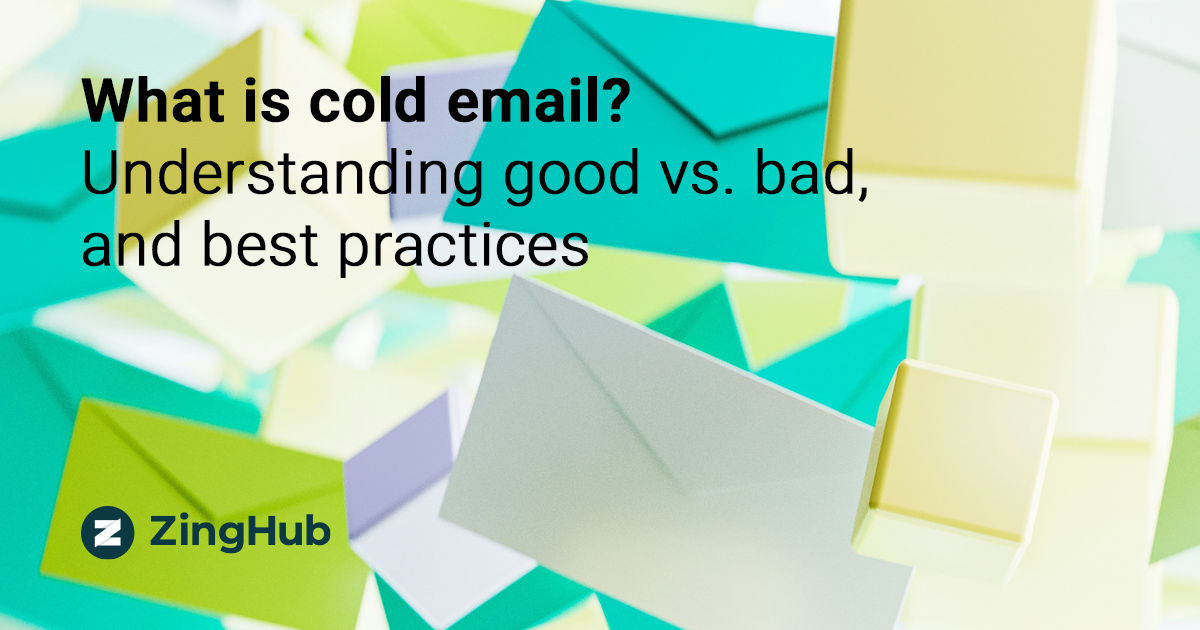
Key Highlights:
A good cold email is recipient-focused and delivers clear value. A good cold email is highly personalized, with actual research having been done on the prospect's business, job, or recent activity. A good cold email delivers a clear value proposition, with a clear statement of how a solution will address a known pain for the recipient, not self-promotion. Good cold emails are short, readable, and contain one low-commitment ask, with the next step easy to understand and clear to the recipient.
Conversely, a bad cold email is generic and self-serving and does not speak to the recipient's own specific needs. Bad emails typically contain little or no customer-level personalization beyond a name, which is to say no research has been done. They may have generic subject lines, too promotional of an approach, or multiple confusing calls to action.
Bad cold emails typically end up in the spam folder for bad deliverability or get deleted outright because they offer no immediate, glaring value to the busy recipient.
Effective cold email sending requires a well-thought-out cold email strategy focused on the recipient's needs and experience. This strategy entails systematic prospect research and list segmentation to make messages relevant to particular groups. It also entails the scheduling of a series of value-based follow-ups since the initial emails never get a response.
Lastly, continuous testing and optimization of all the elements of the emails are essential in sustaining improvement.
Artificial intelligence has totally changed the way professionals are applying cold outreach. AI cold email generator is software that helps in writing customized and effective email copy. Such software has the capability of going through enormous datasets, for instance, publicly available data about your prospects, to provide highly relevant customized snippets, talking points, and even complete email copies.
AI cold email tools such as ZingHub can handle monotonous tasks so marketing and sales professionals can devote more time to strategy and building relationships. They eliminate "writer's block" and can deliver consistency in personalized messaging to large lists of outreach. It must be noted, however, that although AI can provide a good foundation, human touch is still necessary for infusing real empathy and strategic nuance in order to truly connect with the recipients.

Implementing clear best practices is vital for consistent, scalable, and compliant cold email campaigns. These practices ensure every step of your outreach process is standardized and efficient, allowing teams to maintain quality and track performance effectively.
Prospect Research & List Building
Establish clear guidelines for identifying target leads, gathering accurate contact information, and segmenting lists based on specific criteria. This ensures your outreach is always directed at the most relevant recipients.
Email Personalization & Copywriting
Define steps for researching individual prospects and integrating personalized elements into email templates. Create templates for different segments, detailing how AI tools can be used for initial drafts while emphasizing the need for human review and refinement.
Campaign Setup & Scheduling
Outline the process for setting up new campaigns in your chosen platform, including defining sending limits, setting time zones, and assigning email accounts. This ensures campaigns run smoothly and consistently.
Follow-up Sequences
Standardize the number, timing, and content of follow-up emails for different scenarios. Each follow-up should add value or offer a new perspective, gradually guiding the prospect towards a desired action.
Performance Tracking & Optimization
Detail how to monitor key metrics such as open rates, reply rates, and conversion rates. Establish a routine for A/B testing different elements and making data-driven adjustments to improve future campaigns.
Compliance & Deliverability Checks
Implement checks to ensure all emails comply with relevant regulations (e.g., GDPR, CAN-SPAM) and best practices for email deliverability. This includes verifying email addresses and monitoring domain reputation to avoid spam folders.
Most sales and marketing technology research repeatedly indicates the impact of personalization on the success of cold emails. Research has demonstrated that a single personalized sentence can increase reply rates significantly; for example, some research indicates that personalized email copy increases average response rates by 32.7%. Similarly, personalized subject lines are 26% to 50% more likely to be opened compared to generic ones. This is strong evidence supporting the suggestion that effort put into personalizing messages directly leads to engagement.
Cold email is not new; it is still an effective direct communication channel. With knowledge of what is a cold email, good practice and bad practice, and by implementing a well-thought-out cold email strategy with clear best practices behind it, you'll be in a position to convert initial contact into valuable business relationships. By using tools such as an AI cold email generator (e.g., ZingHub) to increase personalization, you will unlock the door to real connection and sustainable growth.
AI-Powered Outreach that Starts Real Conversations. ZingHub.